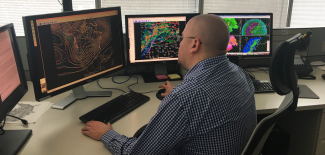NCAR and NOAA are each adopting a unified approach to coupled environmental modeling, where success for both efforts is critically dependent on community contributions. At the end of January 2019, NCAR and NOAA signed a Memorandum of Agreement (MOA) to develop a shared infrastructure that encourages the broader community to engage in improving the Nation’s weather and climate modeling capabilities. Collaborating on the development of a common infrastructure will reduce duplication of effort and create common community code repositories through which future research advances can more easily benefit the operational community. NOAA will also be able to leverage NCAR experience to provide community access and support for NOAA’s operational models and tools. The MOA focuses on seven key elements of common infrastructure for the NOAA Unified Forecast System (UFS) and the NCAR Unified Community Model (UCM).
Coupling between Components - NCAR and NOAA have already developed an initial design for a new framework for coupling component models. This common mediator framework will ultimately accommodate evolving model coupling strategies, facilitating community research contributions and accelerating the transition of research into operations.
Coupling within a Component - A flexible framework for a common interface that allows interoperability / integration of physics packages within component models offers many near term and longer term benefits. NCAR and NOAA are initially focusing on implementing such an interface for the community atmospheric models. The Common Community Physics Package (CCPP) developed by the DTC’s Global Model Test Bed (GMTB) through NGGPS funding, which is being implemented in NOAA’s atmospheric models, has paved the way for a collaborative approach with NCAR’s Community Physics Framework (CPF).
Workflow - Workflow in this context refers to all the infrastructure, code and datasets needed to configure, build and run an end-to-end forecast system utilizing a coupled model for a specific application. NCAR’s well-documented and user-friendly workflow infrastructure known as CIME (Common Infrastructure for Modeling the Earth) and its Case Control System (CCS) makes coupled Earth System Modeling easily accessible in the face of increasing complexity. NCAR and NOAA have already begun exploring a common workflow infrastructure using a CIME/CCS based approach to provide a portable workflow for the larger community.
Quality Assurance Testing - Testing is critical to ensuring software quality and that code performs as expected. Given CIME already contains elements of quality assurance testing, NCAR and NOAA are planning to adapt CIME and the CCS to provide a common testing framework for both research and operations.
Forecast Verification - Using the same toolkits in research and operations, as well as weather and climate, reduces duplication of work and accelerates the transition of innovations from research to operations. Supporting sustained improvement of coupled models will require tools that provide approaches more relevant to research, as well as considering output relevant to coupled processes. The Model Evaluation Tools (MET), a community-supported software package, is a comprehensive set of tools for diagnostic evaluation of atmospheric models that can be expanded to address environmental component models beyond weather such as ocean, waves, and sea-ice. This expansion will take advantage of existing evaluation packages for other component models.
Software Repository Management - Effective community software development requires open access repositories. All infrastructure and supporting code developed under this MOA will reside in open-access GitHub repositories. The management of these repositories will enable collaborative development across the wider research community and include governance, quality assurance, and workflow tools.
User and Developer Support - A robust infrastructure for providing user and developer support is key to engaging the broader community in advancing the capabilities of both NCAR’s UCM and NOAA’s UFS. This infrastructure will leverage existing practices and protocols developed for the NCAR’s community models (CESM, WRF and MPAS), as well as support efforts provided by the DTC for NOAA’s community codes (GSI/EnKF, HWRF, UPP and CCPP) and MET, to provide active and passive user support for the UFS and UCM.
The result of this MOA will be a state-of-the-art, well-documented and easy-to-use modeling system. Coordinating existing and ongoing investments and governance between NOAA and NCAR ensures alignment with unified coupled community modeling, sets joint priorities and leverages resources.
https://www.noaa.gov/media-release/noaa-and-ncar-partner-on-new-state-of-art-us-modeling-framework
https://www.weather.gov/media/sti/nggps/18-064553_SignedMOU.pdf
